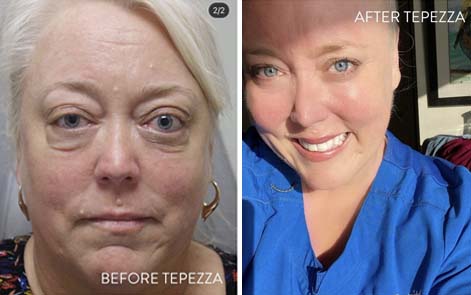What is Tepezza?
Home » What is Tepezza?
Tepezza: Q&A for Patients with Thyroid Eye Disease (TED)
- What is the only FDA-approved treatment for TED?
Tepezza ,or teprotumumab, is the only FDA approved treatment for TED. Prior to its approval in 2020, management options for TED were limited and consisted of non-specific treatment alternatives such as high dose steroids, radiation, or use of biologic drugs, all of which have the potential for serious side effects. However, groundbreaking research including multiple international clinical trials demonstrated the effectiveness of Tepezza in reversing TED, and led to the approval of Tepezza as the first and only FDA approved treatment for TED.
- What were the limitations of treatment options for TED before Tepezza?
Treatment options were limited and consisted of high-dose steroids, radiation, or biologic drugs, all with potential side effects. However, groundbreaking research including multiple international clinical trials demonstrated the effectiveness of Tepezza in reversing TED, and led to the approval of Tepezza as the first and only FDA approved treatment for TED.
- How does Tepezza work?
Tepezza is a human monoclonal antibody to the insulin like growth factor 1 receptor (IGF-1R). This receptor has been found to be overexpressed in orbital tissues of patients with TED. Tepezza is considered a breakthrough therapy because it binds to the IGF-1R specifically overexpressed on TED tissues and turns down the production of extracellular molecules, and the subsequent inflammation and tissue expansion associated with TED. In short, this means the disease reverses with less eye bulging, double vision, facial changes and swelling.
- How is Tepezza administered?
Tepezza is given intravenously under the direct supervision of a TED specialist in eight infusions separated every three weeks. Each infusion is typically well tolerated and most patients start to see results after two infusions.
- What percentage of patients see improvement with Tepezza treatment?
In clinical trials published by Dr. Douglas, over 80% of patients saw improvement and of those 95% had long term improvement. The rate of reactivation of disease appears stable at 5% (meaning about 5% of patients may require retreatment).
- What are barriers for TED treatment?
While Tepezza has changed the field of TED management, there remain barriers to treatment. First, Tepezza must be approved by your insurance prior to treatment. See our insurance section and get hands on help for any insurance related questions. Second, like all medications Tepezza has potential side effects. These side effects appear mild or moderate and most resolve during or shortly after therapy. However, this is something that your prescribing physician should be aware of and monitor you closely for.
- What are the most common side effects of Tepezza?
The most common side effects are muscle spasms, which typically resolve following treatment. Some patients may also experience nausea, hair loss, fatigue, and diarrhea. Approximately 10% of patients experience changes in hearing such as hearing your own voice. Additionally, approximately 10% of patients may see a rise in their blood glucose level. It is important to have a complete discussion of the side effects before considering therapy, and to evaluate the potential risks and benefits with your treating physician. Intravenous hydration with vitamins and minerals following Tepezza infusion appears to lessen the severity of some side effects, and can be considered if offered by your infusion center. If you have inflammatory bowel disease (IBD) such as Crohn’s disease or ulcerative colitis, Tepezza may make your IBD worse.

